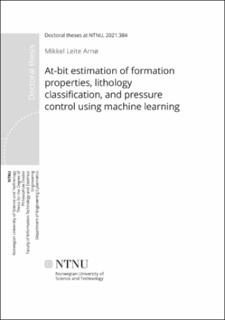| dc.contributor.advisor | Aamo, Ole Morten | |
| dc.contributor.author | Arnø, Mikkel Leite | |
| dc.date.accessioned | 2021-12-13T11:11:02Z | |
| dc.date.available | 2021-12-13T11:11:02Z | |
| dc.date.issued | 2021 | |
| dc.identifier.isbn | 978-82-326-5884-8 | |
| dc.identifier.issn | 2703-8084 | |
| dc.identifier.uri | https://hdl.handle.net/11250/2833964 | |
| dc.description.abstract | The petroleum drilling process involves an array of complicated operations necessary to create circular wellbores to allow the exploration and recovery of hydrocarbons. Examples of these are overcoming the resistance, crushing, and removal of rock, maintaining wellbore stability, and avoiding fracture and influx of formation fluids. As wellbores can extend for several kilometers underground, much of the operation is hidden from the driller, which must rely on topside and downhole sensor measurements for indications of which actions are preferable, and also to understand the state of the process. The amount of available measurements has increased gradually, and it is of interest to convert these measurements to value. However, analysis of large amounts of data is challenging and time-consuming for humans, and too much information could even be counterproductive.
This Ph.D. thesis is concerned with the use of machine learning (ML) methods to make use of the data available during drilling. A deep reinforcement learning agent is trained to control bottomhole pressure during pipe connection in a simulated study. Also, a streaming learning method using deep neural networks (DNNs) is presented in order to both estimate logging while drilling (LWD) sensor readings, as well as classifying lithology. This method uses drilling parameters as inputs, and learns continuously from the available data stream to adapt to case-specific and changing conditions during operation. This approach is applied to real drilling data from the reservoir section of a field operated by Equinor. The results herein presented indicate that such a configuration can be used to provide preliminary at-bit indications of lithology characteristics, which can be used by the driller as a tool in the decision-making process. Such predictions can contribute to a better foundation for selection of suitable drilling parameters, leading to a safer and more efficient drilling operation. | en_US |
| dc.language.iso | eng | en_US |
| dc.publisher | NTNU | en_US |
| dc.relation.ispartofseries | Doctoral theses at NTNU;2021:384 | |
| dc.relation.haspart | Paper A: Arnø ML, Godhavn J-M, Aamo OM. At-bit estimation of rock density from real-time drilling data using deep learning with online calibration. In Journal of Petroleum Science and Engineering, page 1009006, 2021 https://doi.org/10.1016/j.petrol.2021.109006 | en_US |
| dc.relation.haspart | Paper B: Arnø ML, Godhavn J-M, Aamo OM. A divided and prioritized experience replay approach for streaming regression. MethodsX | en_US |
| dc.relation.haspart | Paper C: Arnø ML, Godhavn J-M, Aamo OM. At-bit virtual neutron log estimated from real-time drilling data. SPE/IADC International Drilling Conference and Exhibition. | en_US |
| dc.relation.haspart | Paper D: Arnø ML, Godhavn J-M, Aamo OM. Classification of drilled lithology in real-time using deep learning with online calibration. SPE Drilling & Completion. | en_US |
| dc.relation.haspart | Paper E: Arnø ML, Godhavn J-M, Aamo OM. Real-time classification of drilled lithology from drilling data using deep learning with online calibration. In proceedings of the SPE/IADC International Drilling Conference and Exhibition, SPE-204093-MS https://doi.org/10.2118/204093-MS | en_US |
| dc.relation.haspart | Paper F: Arnø ML, Godhavn J-M, Aamo OM. Deep reinforcement learning applied to managed pressure drilling. In proceedings of the SPE Norway Subsurface Conference, SPE- 200757-MS https://doi.org/10.2118/200757-MS | en_US |
| dc.title | At-bit LWD estimation, lithology classification, and pressure control using machine learning | en_US |
| dc.type | Doctoral thesis | en_US |
| dc.subject.nsi | VDP::Technology: 500::Information and communication technology: 550::Technical cybernetics: 553 | en_US |

